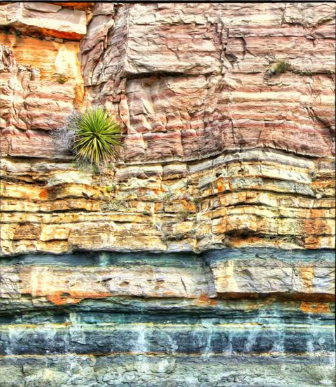Sedimentary rock forms from bits of rocks deposited over time by wind and/or water. Rocks occur in all sizes. The tiny amounts of mud, pebbles, sand grains, and smaller rock particles can form sedimentary rock. Sediment can also contain the remains of once living things. This may be bones, shells, droppings, leaves or stems. Wind and water carry sediments and deposit them in layers usually in a lake or ocean bottom. The processes that turn sediments into solid rock are compaction and cementation. The processes of compaction and cementation together are known as sedimentation.

Compaction
At first, the fragments of rock lie loosely together. But gradually, over many, many years these thick layers build up. This build up becomes heavy and presses down on the layers beneath it. Compaction is the pressing down of layers forcing the sediments to fit closer together. Over millions of years, this process can squeeze fragments tightly together. The layers often remain visible in the rock and may be used to identify sedimentary rock.
Cementation
During the process of compaction, the minerals in the rock are dissolving. These dissolved minerals fill in the spaces between sediment particles. Cementation is the process of sediments being glued tightly together. The processes of erosion, deposition, compaction, and cementation may occur over millions of years transforming rock fragments into solid rock.
The 550-km long Rio Grande rift is what makes up this basins sedimentary layers. It's made up of four structurally linked basins in the central part of the rift. These were mostly developed and subsided during the Miocene and Pliocene and are filled with poorly lifted siliciclastic sediments and a variety of intrusive and extrusive rocks.

Some layers are also made up of eolian, flu-vial and alluvial sediments from the Santa Fe Group.
These all have had actions in this area and are responsible for the movement you see here before you.
The following Material were used for Reference:
- New Mexico state Geology Department
- U.S. Department of the Interior, Professional papers and Geological surveys
- Wikipedia
- California Institute of Technology
- geoinfo,nmt.edu/publications/maps Chimayo report
- Wikipedia
Logging Requirements: Please E-Mail me the answers, don't post any pictures of the site itself.
1. Type in GC7C50K Espanola Basin Sediments. How many in your party today?
2. How many big layers do you count in a 20 foot section?
3. What are the main colors in these layers?
4. What type of Sedimentation do you think made these layers?
5. Is there angle of tilt that you can see? What is the angle if one is seen?